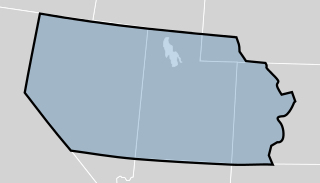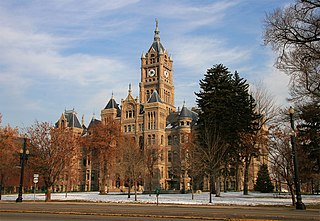
The Chicago Public Library (CPL) is the public library system that serves the City of Chicago in the U.S. state of Illinois. It consists of 80 locations, including a central library, two regional libraries, and branches distributed throughout the city's 77 Community Areas.

Temple Square is a 10-acre (4.0 ha) complex, owned by The Church of Jesus Christ of Latter-day Saints, in the center of Salt Lake City, Utah. In recent years, the usage of the name has gradually changed to include several other church facilities that are immediately adjacent to Temple Square. Contained within Temple Square are the Salt Lake Temple, Salt Lake Tabernacle, Salt Lake Assembly Hall, the Seagull Monument, and two visitors' centers. The square was designated a National Historic Landmark District in 1964, recognizing the Mormon achievement in the settlement of Utah.

The Berkeley Public Library is the public library system for Berkeley, California. It consists of the Central Library, Claremont Branch, North Branch, West Branch, Tarea Hill Pittman South Branch—and the Tool Lending Library, which is one of the nation's first such libraries.

Milwaukee Public Library (MPL) is the public library system in Milwaukee, Wisconsin, United States, consisting of a central library and 13 branches, all part of the Milwaukee County Federated Library System. MPL is the largest public library system in Wisconsin.

The Salt Lake Masonic Temple is the Masonic headquarters for Utah, and is Salt Lake City's best example of Egyptian Revival architecture. It was completed in 1927, and is located in the South Temple Historic District of Salt Lake City, Utah, United States.
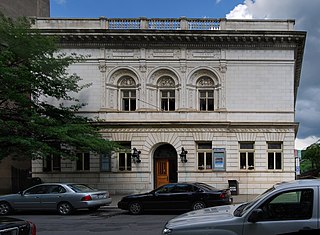
The Troy Public library is the main public library building in the city of Troy, New York, and is located across the street from Russell Sage College in downtown Troy. Currently, the library has one other location, the Lansingburgh branch, which had been temporarily closed in 2009 due to budget concerns. The Sycaway branch was also temporarily closed in January 2009 but has been closed permanently since 2011. The first library began in 1799. The current building was completed in 1897 and is listed on the National Register of Historic Places, both in its own right and as a contributing property to the Central Troy Historic District.

The Miami-Dade Public Library System (MDPLS) is a system of libraries in Miami-Dade County, Florida, United States.

The Mobile Public Library is a public library system primarily serving Mobile County, Alabama. The system is a department of the city of Mobile and receives funding from Mobile County and the city of Saraland.

Liberty Park is a popular public urban park in Salt Lake City, Utah. It is the city's second-largest public park, at 80 acres (32 ha), being surpassed only by Sugarhouse Park which has 110.5 acres (44.7 ha). The park features a pond with two islands, and is also the location of Tracy Aviary. The park is listed on the National Register of Historic Places (NRHP) and it includes the Isaac Chase Mill, which is also NRHP-listed.
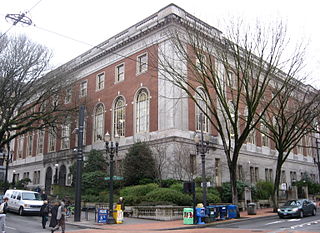
The Central Library is a three-story public library branch in downtown Portland, Oregon, United States. Opened in 1913, it serves as the main branch of the Multnomah County Library system. The Georgian style building was added to the National Register of Historic Places as the Central Building, Public Library in 1979 and underwent major renovations in 1997.
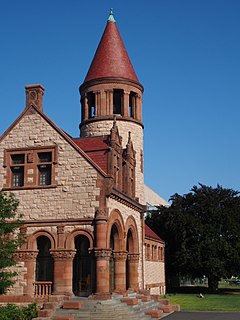
The Cambridge Public Library in Cambridge, Massachusetts is part of the Minuteman Library Network. It consists of a main library and six branches, located throughout the city.
Ware & Treganza was a leading American architectural firm in the intermountain west during the late 19th and early 20th century. It was a partnership of Walter E. Ware and Alberto O. Treganza and operated in Salt Lake City, Utah.

The Chapman Branch Library in Salt Lake City, Utah, United States, is a Carnegie library that was funded by a $25,000 Carnegie Foundation grant and was built in 1918. It was listed on the National Register of Historic Places in 1980.

The Ladies Literary Club Clubhouse, at 850 East South Temple St. in Salt Lake City, Utah, was built in 1913. It was designed by architects Treganza & Ware in Prairie School style.
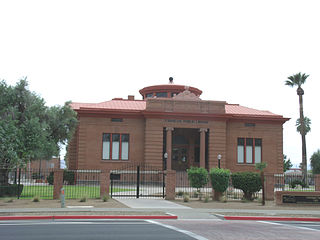
The Phoenix Carnegie Library and Library Park, now known as the Carnegie Center, is a historic site in Phoenix, Arizona. Completed in 1908, it was listed on the National Register of Historic Places in 1974.

The former Lake City Public Library is a historic structure located in Lake City, Iowa, United States. Efforts to establish a library began as early as 1889 when community socials were held to raise money for books. Women in the community, however, would not form a community library association until 1905. They sought donations of books and money from the community and were able to set up a subscription that year in the old primary building next to Central School. By 1908 there were 1,500 volumes in the library. The Association proposed to the city council in February of the same year that they turn their holdings over to the city for a free library. The council agreed to submit the proposal to the voters and the Association petitioned the Carnegie Corporation of New York for funds to build a new building. They accepted Lake City's application for a grant for $7,500 on May 8, 1908, and approved the library proposal in early June. S.T. and E.S. Hutchison donated the property. Denison, Iowa architect Edgar Lee Barber designed the Neoclassical building that was built by Nelson Construction Company. It opened in April 1910. There was no formal dedication. The building was listed on the National Register of Historic Places in 1990. The community has subsequently built a new library, and this building now houses a commercial business.
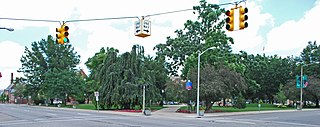
Bronson Park Historic District is a historic district in Kalamazoo, Michigan, consisting of Bronson Park and the surrounding government, religious, and civic buildings. It is roughly bounded by South Rose, South Park, West Lovell, and West Michigan Avenues. The district was listed on the National Register of Historic Places in 1983.





